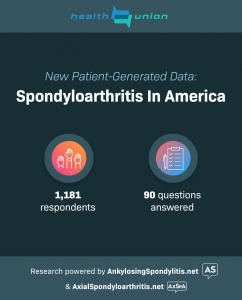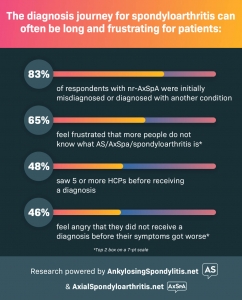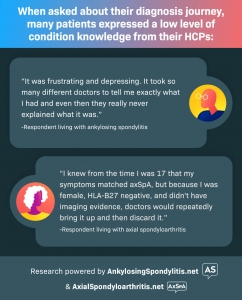Spondyloarthritis In America
New Health Union survey data helps the healthcare industry better understand and reach people living with spondyloarthritis
For the second consecutive year, Health Union has gathered patient-reported data from over 1,000 people living with spondyloarthritis, this year via two online health communities — AnkylosingSpondylitis.net and AxialSpondyloArthritis.net. Spondyloarthritis In America, a syndicated research study from Health Union, looks beyond the basics, detailing more than just demographics and symptoms, to establish a holistic snapshot of the patient journey of those affected, and track trends over time.
The new data from the second annual Spondyloarthritis In America uncovers the experiences of 1,181 diagnosed patients, and explores the often difficult spondyloarthritis diagnosis journey. 83% of respondents with nr-AxSpA were initially misdiagnosed or diagnosed with another condition, and 65% feel frustrated that more people do not know what AS/AxSpA/spondyloarthritis is.* 48% of respondents saw 5 or more healthcare professionals before receiving a diagnosis, and 46% feel angry that they did not receive a diagnosis before their symptoms got worse.*
*Top 2 box on a 7-pt scale
When asked about their diagnosis journey, many expressed a low level of condition knowledge from their healthcare professionals:
“It was frustrating and depressing. It took so many different doctors to tell me exactly what I had and even then they never really explained what it was.”
– Survey respondent living with ankylosing spondylitis
“I knew from the time I was 17 that my symptoms matched AxSpA, but because I was female, HLA-B27 negative, and didn’t have imaging evidence, doctors would repeatedly bring it up and then discard it.”
– Survey respondent living with axial spondyloarthritis
Through a growing portfolio of condition-specific online communities, like AnkylosingSpondylitis.net and AxialSpondyloArthritis.net, Health Union’s continuous immersion in the patient experience delivers smarter insights and implications–so you can spend your time developing the strategies that will make a difference.





